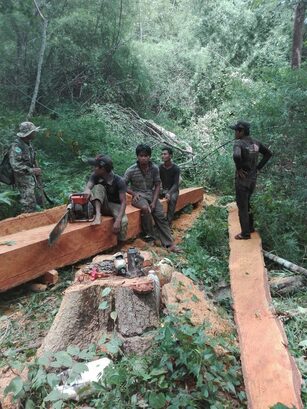A complex environment

Despite being a remarkable site with a myriad of significant archaeological sites indicating the existence of a royal capital, Phnom Kulen is facing many challenges: environmental, demographic, socio-economic, heritage protection, among others.
Due to its strategic location and difficult access, the Khmer Rouge used Phnom Kulen as a stronghold from 1970 till 1996. As a result, unexploded ordnance and landmines contaminate many places and remain a looming threat for the local population. Antipersonnel mines, unexploded mortar shells and other explosive remnants of war are regularly found and destroyed by deminers at the request of ADF or local authorities.
There is an estimated population of 4,800 currently distributed over ten villages on Kulen Mountain. Most of the villagers are subsistence farmers growing rain-fed upland rice, cassava, sweet potatoes, beans, etc. They practice ‘slash and burn’ agriculture, clearing and burning plots of land, farming for one year, then abandoning it back to the forest. However and since 2000, many plots used for rice production have been converted to permanent plantations of cashew nut trees, forcing the population to clear new patches of forest for agriculture.
With a fast growing population, the impact on the environment and the challenges to public health, education and socio-economic development are increasing. Moreover, hardwood trees are often logged illegally for villagers themselves or at the request of influential people, then sold expensively on the Cambodian market.
The access to Phnom Kulen is currently managed as a private concession, and the unregulated tourism development results in illegal constructions on ancient sites, unregulated access to vulnerable areas, uncontrolled in-migration, litter and pollution. ADF's main institutional partners, the APSARA National Authority and the Ministry of Environment, are working towards addressing these issues, with the technical expertise of ADF.
Due to its strategic location and difficult access, the Khmer Rouge used Phnom Kulen as a stronghold from 1970 till 1996. As a result, unexploded ordnance and landmines contaminate many places and remain a looming threat for the local population. Antipersonnel mines, unexploded mortar shells and other explosive remnants of war are regularly found and destroyed by deminers at the request of ADF or local authorities.
There is an estimated population of 4,800 currently distributed over ten villages on Kulen Mountain. Most of the villagers are subsistence farmers growing rain-fed upland rice, cassava, sweet potatoes, beans, etc. They practice ‘slash and burn’ agriculture, clearing and burning plots of land, farming for one year, then abandoning it back to the forest. However and since 2000, many plots used for rice production have been converted to permanent plantations of cashew nut trees, forcing the population to clear new patches of forest for agriculture.
With a fast growing population, the impact on the environment and the challenges to public health, education and socio-economic development are increasing. Moreover, hardwood trees are often logged illegally for villagers themselves or at the request of influential people, then sold expensively on the Cambodian market.
The access to Phnom Kulen is currently managed as a private concession, and the unregulated tourism development results in illegal constructions on ancient sites, unregulated access to vulnerable areas, uncontrolled in-migration, litter and pollution. ADF's main institutional partners, the APSARA National Authority and the Ministry of Environment, are working towards addressing these issues, with the technical expertise of ADF.
